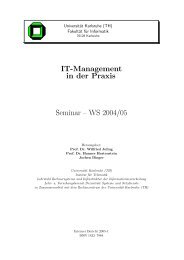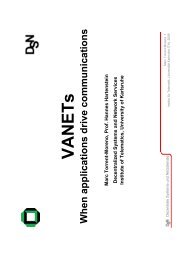Download PDF - KIT
Download PDF - KIT
Download PDF - KIT
Create successful ePaper yourself
Turn your PDF publications into a flip-book with our unique Google optimized e-Paper software.
ased on i), locally execute the FPAV algorithm from [14]<br />
to compute the optimal CCF solution for the nodes within<br />
(maximum) carrier sense range; iii) exchange the locally computed<br />
transmission power values with surrounding vehicles;<br />
iv) select the minimum transmission power value among the<br />
one locally computed and those computed by surrounding<br />
vehicles in order to build the network-wide optimal solution<br />
to CCF.<br />
The FPAV algorithm of [14] is a centralized algorithm based<br />
on the well-known “max-min” principle: the transmission<br />
power of all vehicles in a surrounding area is ‘virtually’<br />
increased step-by-step (starting at lowest possible power level),<br />
while estimating the resulting application load at each vehicle<br />
after each step. As long as the MAL threshold is not violated<br />
at any vehicle, and the maximum allowed transmission power<br />
has not been reached, power levels are further increased. Upon<br />
termination, FPAV has thus computed the highest common<br />
transmission power level which did not violate the MAL<br />
parameter in the whole network.<br />
In [20], it is formally proven that D-FPAV computes an<br />
optimal solution to CCF under the following assumptions: a)<br />
carrier sense ranges of nodes are symmetric; b) each node is<br />
able to accurately estimate the AL for the next period; and<br />
c) each node is able to gather AL information from all nodes<br />
within maximum carrier sense range. In practical scenarios,<br />
these assumptions are unlikely to hold, due to the complexity<br />
of the propagation environment (a), and difficulties in accurately<br />
predicting AL and gathering AL information (b) and<br />
(c). Yet, in [20] it is shown through extensive simulation that<br />
D-FPAV successfully solves the CCF problem at least when<br />
assumption c) is released, i.e., when nodes have only partial<br />
knowledge of the AL generated by nodes within maximum<br />
CS range.<br />
In [20], D-FPAV is evaluated in a scenario 1 in which<br />
application-layer load at each node is generated by a beaconing<br />
application, which periodically generates packets to report<br />
vehicle status to nodes in the surrounding area. Beacon messages<br />
are considered low-priority messages in this scenario,<br />
and transmitted using D-FPAV computed transmission power<br />
with lowest EDCA priority class. Besides beaconing messages,<br />
event-driven emergency messages are randomly generated<br />
within the network. These are high-priority messages that are<br />
seldom generated, and, given their safety-critical nature, are<br />
not subject to congestion control. Emergency messages are<br />
sent at maximum transmission power PM using the highest<br />
priority EDCA traffic class.<br />
An important issue to understand in the D-FPAV approach<br />
is the tradeoff between accuracy of channel load estimation on<br />
a vehicle, and additional overhead which is put on the channel.<br />
In fact, as the carrier sense range is typically larger than the<br />
transmission range, the only way to acquire knowledge about<br />
presence of vehicles located outside the transmission range is<br />
by making use of a multi-hop strategy, i.e., having vehicles retransmit<br />
the position of their neighbors. Clearly, propagating<br />
this information in a multi-hop manner puts an additional load<br />
1 For details on the simulation scenario, including features of the radio<br />
environment, please see [20].<br />
Probability Of Message Reception<br />
1<br />
0.8<br />
0.6<br />
0.4<br />
0.2<br />
0<br />
Event-driven D-FPAV-On<br />
Event-driven D-FPAV-Off<br />
Beacon D-FPAV-On<br />
Beacon D-FPAV-Off<br />
100 200 300 400 500 600 700 800 900 1000<br />
Distance to Sender [m]<br />
Fig. 4. Probability of successful reception of periodic beacon and emergency<br />
messages at varying distances. MAL is set to 2.5Mb/s.<br />
on the channel, which can be considered as control overhead.<br />
In order to optimally tune the above described tradeoff, the<br />
following design decisions have to be made: how often the<br />
status of neighboring vehicles should be forwarded, what range<br />
of neighbors must be included, and which transmission power<br />
must be used to transmit this information.<br />
The following strategies have been considered in [20]:<br />
piggyback the aggregated status information (position of surrounding<br />
vehicles) to 1) each beacon, 2) every 5th beacon or<br />
3) every 10th beacon, and transmit it with power PA(i) (the<br />
transmit power value as computed by D-FPAV). The authors<br />
found that piggybacking aggregate status information in 1 out<br />
of 10 beacon messages results in the best compromise between<br />
control overhead and effectiveness of congestion control.<br />
The probability of correctly receiving a beacon or emergency<br />
message as a function of distance with and without<br />
D-FPAV is reported in Figure 4. As seen from the figure,<br />
EDCA alone is not sufficient to clearly prioritize emergency<br />
over beacon messages. On the other hand, D-FPAV achieves<br />
a clear prioritization of emergency over beacon messages,<br />
i.e. emergency messages have a consistently higher reception<br />
probability in the whole range of transmission distances. It<br />
is also interesting to observe that D-FPAV congestion control<br />
mechanism has beneficial effects not only on high priority<br />
traffic, but also on low-priority traffic (beacons): in fact, their<br />
reception probability at close distances from the transmitter<br />
(within 150m) is considerably higher than when no congestion<br />
control exists.<br />
The effectiveness of the D-FPAV approach in achieving<br />
fair channel access opportunities is shown in Figure 5, which<br />
reports the channel access time of vehicles as a function of<br />
their position on the road: without D-FPAV, channel access<br />
time depends highly on the density of vehicles in the surroundings,<br />
and it is thus unfairly distributed. On the other hand,<br />
when D-FPAV is active, the load generated by the beaconing<br />
application is kept under control, and channel access time is<br />
nearly constant throughout the network.<br />
In a follow-up study [24], we showed that in order to<br />
effectively guarantee a strict enforcement of an upper channel<br />
load limit and to provide fairness with respect to channel<br />
access opportunities, it is necessary to propagate the position<br />
8




